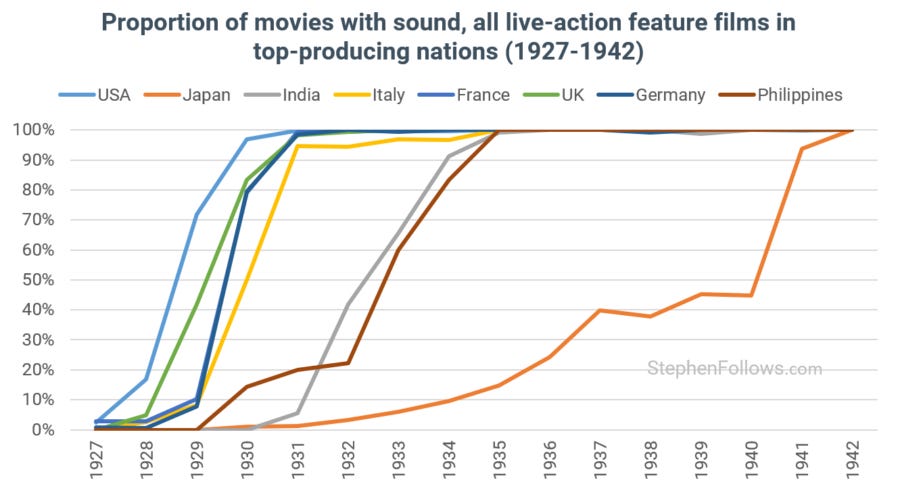When did talkies take over from silent movies?
This is the second half of a mini-project I set myself to pay penance for not paying enough attention during film school.
In a previous article, I examined when colour movies became more prevalent than black-and-white ones. Today, I am considering the introduction of sound.
My dataset contains all live-action feature films I could find—377,967 to be precise—released between 1900 and 2023. I then looked at whether any part of the film had sounded synchronised to the picture (i.e., not those that expected a live pianist or organist to accompany it in the theatre).
When did sound take over movies?
The evolution from silent to sound cinema, commonly referred to as "talkies," marks one of the most significant transitions in film history. It ultimately revolutionised the film industry and the movie-going experience.
One of the milestone films to showcase this new technology was "The Jazz Singer" released in 1927. Although not the first sound film, it was the first to achieve major commercial success and is often credited with heralding the sound era in cinema.
As studios began to retrofit their theatres with sound systems, other notable talkies followed. 1928 saw Warner Bros. release "Lights of New York", the first all-talking full-length feature film, and Dinsey premiered "Steamboat Willie", the first cartoon with synchronised sound (as well as introducing Mickey Mouse to the world).
The transition to sound was not without its difficulties. Many silent film actors struggled with the shift, as their voices did not always match their onscreen personas. Directors and crew had to grapple with new challenges, such as the need for soundproof sets and the restriction of camera movements due to the noise of early sound recording equipment.
To answer our headline question - it was in 1930 that the number of talkies released matched the number of silent films. It is staggering when you consider that just a few years earlier, there had been no commercial sound releases.
Which country moved to sound first?
As we saw with the adoption of colour film, the situation differed around the world.
In the United States, a mere 2.3% of films included sound in 1927. By 1929, this had soared to 71.8%, and by 1930, a dominant 96.9% of American films were talkies. It's hard to imagine such a rapid change in the nature of a major pastime over just a couple of years.
The UK was quick to follow, as were France and Italy. One of the slowest top-producing nations to adopt sound was the Japanese industry, not reaching a 'sound majority' until 1940.
This is a vast and fascinating topic but I shall stop here, so as to say within the area I know - film data. If anyone wants to suggest what else to do with this data, I'm all ears!
Notes
This looked at live-action feature films, using data from OMDb, IMDb, Wikipedia and my own datasets.
In the early days of film, the notion of a ‘feature film’ was still in flux, and so some of my data includes films shorter than we would expect today from “A Feature Film.” That said, by the time sound was introduced, the running times were closer to what we, as modern movie watchers, expect.





